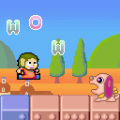Marvel Land is Namco’s attempt at a comical platformer, in the vein of Super Mario Bros. It stars Prince Paco, a dragon child, as he runs and jumps through Marvel Land, the eponymous theme park. His goal is to rescue the four fairies, including Princess Luxy, that have been kidnapped by evil King Mole.
The gameplay is straight-forward – just run forward, jump on enemies heads, and collect point items. The hero can only take one hit before he perishing, which sends him back to an earlier checkpoint, or to the beginning of the stage if he’s run out of lives. The game seems easy at first, but the later levels grow quite challenging. There are two power-ups. One will create four shadows, which can be swung around in a circle to both kill enemies and collect items. The other is a pair of dragon wings that allow the hero to jump higher and slow his descent. Both last for a limited amount of time.
One of the few unique elements is the way the game handles physics. Throughout the park are various rides, like swinging canoes, that can be used to propel the hero higher and farther than he can normally jump. There are also gigantic spinning wheels with platforms on them, which you need to navigate carefully, lest you end up falling down, usually into spikes or a pool of lava. These are animated by impressive looking sprite rotation effects.
There are a few other interesting touches. Boss battles are fought via small minigames, rather than traditional fights. Most levels end with a gigantic target marker. Rather than hitting the top of it, like Super Mario Bros., the goal is to fly through the bullseye, granting the most amount of points. Most stages including a roller coaster, where you need to jump over signs and dodge enemies. During the loop-de-loop, the whole screen spins around dizzyingly. The bonus levels take place in a Disney-esque light parade, featuring floats with characters from several Namco games like Pac-Man and Mappy. Lots of other Namco cameos can be seen throughout, like the pink robot at the beginning of each stage. This is Uketsuke Komachi, a real life receptionist robot created in 1985 by Namco.
The levels have a carnival-like atmosphere, of course, ranging from forests to ice caverns to lands created entirely with desserts. Most of the enemies are clever, created by Japanese puns. For example, “batta” is both the Japanese word for a grasshopper, and the word for “batter”, as in a baseball player. So of course, one of the enemies is a baseball playing grasshopper. Other enemies include a whip-wielding dominatrix rose named Barbara (“bara” means rose”), and a turtle/chameleon hybrid called a Kameleon (“kame” meaning turtle).
The Japanese version has an “easy” mode which skips several stages, plus gives help messages when you grab a power-up. The music also sounds different between the Japanese and English version. It’s hard to tell if this was intentional, or is the result of a bug in MAME or bad ROMs.
Though originating the arcades, Marvel Land is more widely known for its Genesis port. While the system doesn’t quite have the technical chops to replicate the arcade game, the game still looks quite colorful, and sounds decent too. Most of the rotational effects have been removed, replaced by obstacles that work similarly. The canoe is replaced by a similarly shaped series of a logs that fly in the same arc; most of the wheels have platforms that move around in a circular pattern without having any wheel rotating in the background. The screen doesn’t spin at all on the roller coasters. There are a few floating platforms that still tilt using a similar effect, though it taxes the Genesis’ CPU to the point where it severely slows down.
Even though it’s missing some of the fancy effects, the Genesis port is a drastically expanded game. The arcade version has 18 levels, including the final escape sequence, while the Genesis version has 29, making for a much longer game. Several new levels are added, and most of the existing ones have added hidden warp points that allow you to skip stages. There’s also a password system. The boss minigames have changed. There were only two in the arcade game. One is a janken match where a slot machine will automatically play a rock-paper-scissors games, and you need to either attack or dodge, depending on the outcome. (In the English arcade version, this was simplified so there’s only a picture of the winner.) The other is a button mashing tug-of-war. The Genesis version keeps the janken match, but adds three others – a balloon pumping competition, a card matching game, and a whack-a-mole challenge. Additionally, there’s an actual boss battle against King Mole at the end.
There are a few other differences too. The English home ports also change some of the names – the hero is now Talmit, and the princess is now Wondra. Paco/Talmit’s friend Bunny is missing her bunny ears, plus his design is slightly different, omitting his pony tail. The Genesis version is missing some of the enemies of the arcade game, but adds several new ones in their places. There’s a new introduction sequence detailing the story. There are a few extra songs, which is good, because the main theme of the arcade game is fun, but also reused too often. The bonus stages also feature new floats.
In the grand scale of things, Marvel Land is hardly the cream of the 16-bit platformer crop. It’s still good though, and quite challenging, even if it’s a bit standard. But in 1990, it was easily one of the best of its type available for the Genesis, at least until Sonic came along.
Other than the Genesis port, the arcade version was also released for the Japanese Wii Virtual Console.
Links:
The Parade of Marvel Land An excellent, comprehensive fan site.

